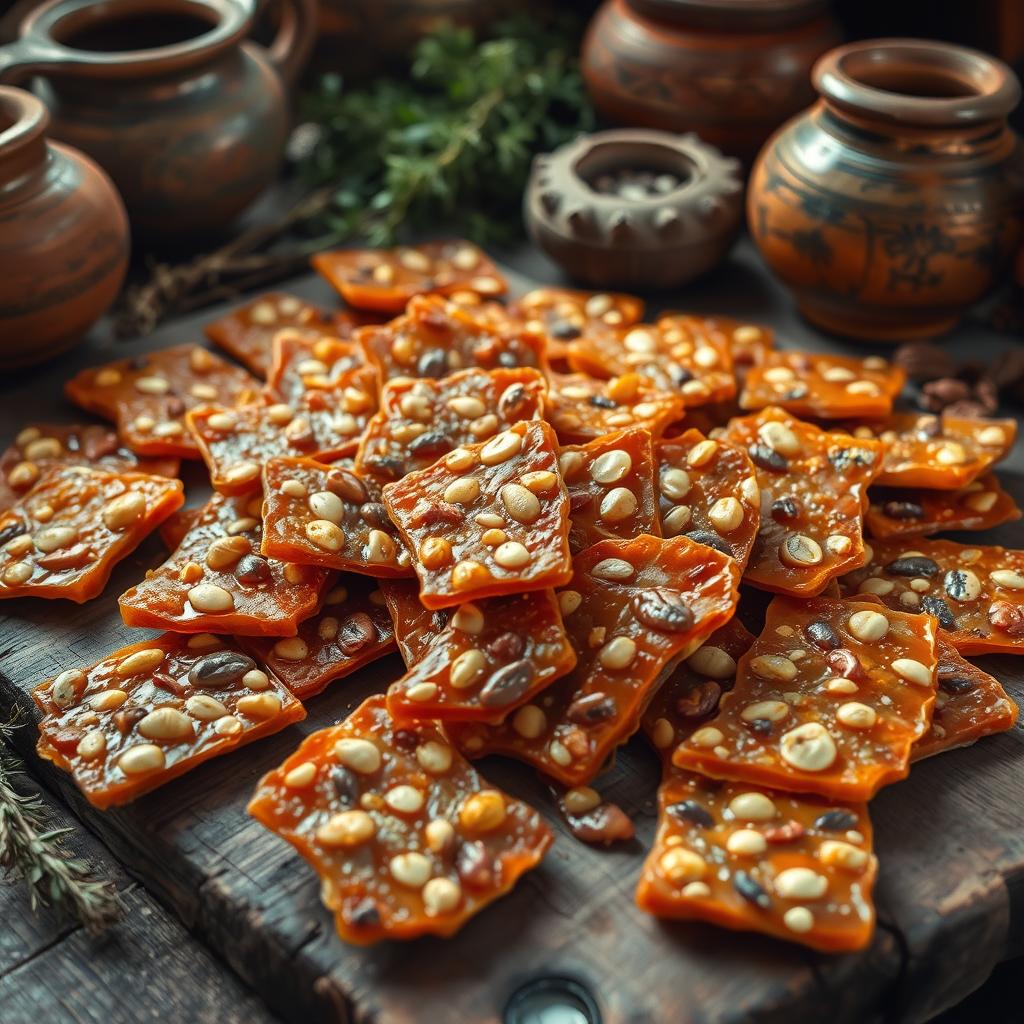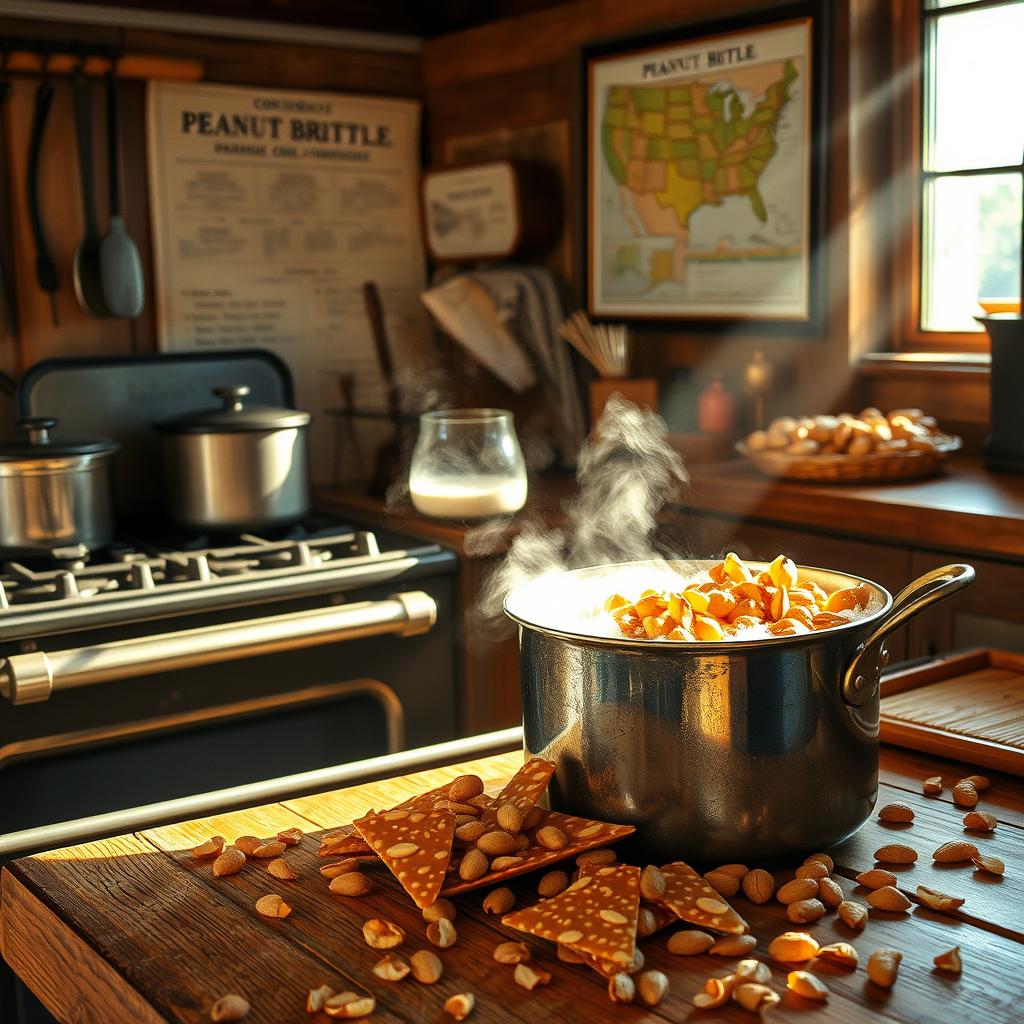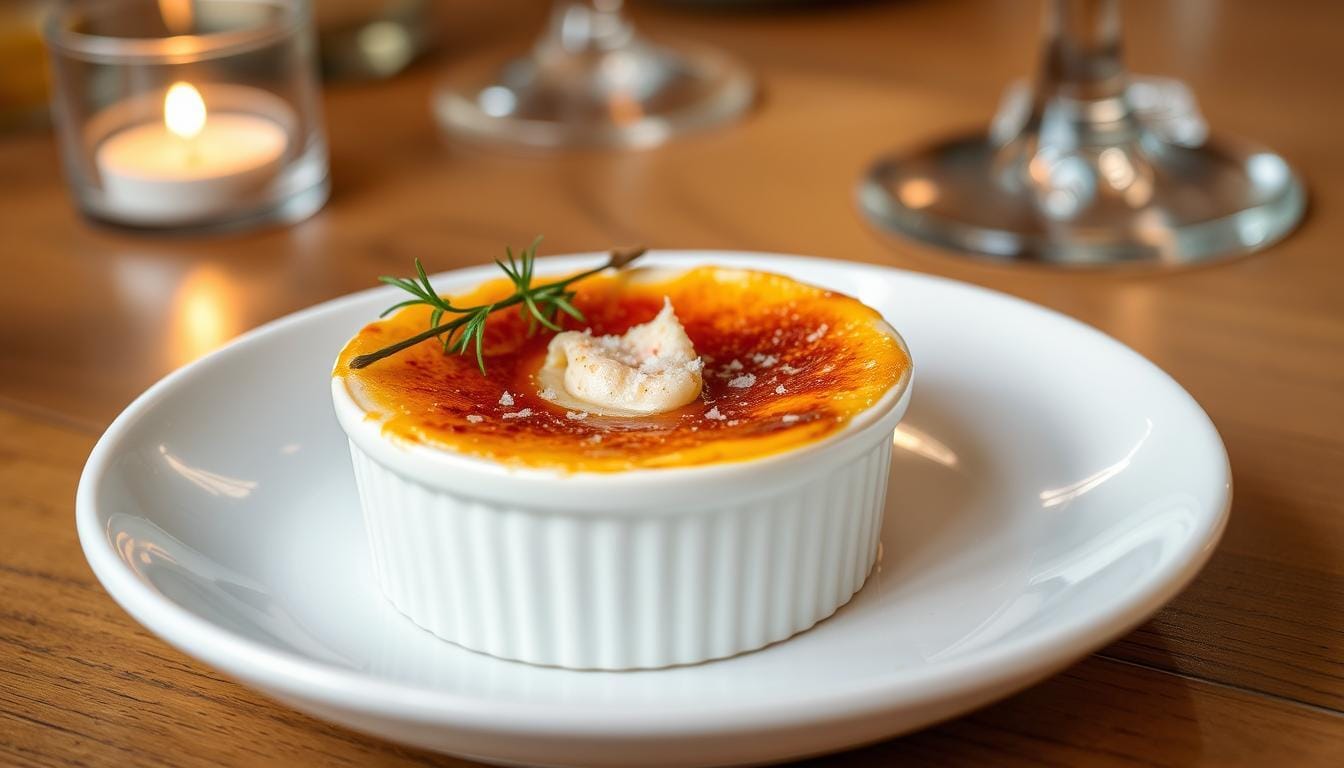Growing up in the Midwest, peanut brittle was a common treat. It brought back memories of cozy winter afternoons and holiday gatherings. The crunch, salty-sweet taste, and aroma were part of my childhood. But, I wondered: is peanut brittle really an American invention?
This question made me curious, leading me to explore peanut brittle’s history. From the Middle East’s spice routes to early America’s candy shops, its story is fascinating. It’s a mix of cultural influences, culinary traditions, and confectioners’ creativity. Let’s dive into the history and global origins of this beloved American treat.

Key Takeaways
- Peanut brittle has ancient roots, with origins tracing back to Middle Eastern candy-making traditions.
- The introduction of peanuts and the development of industrialized sugar production played a crucial role in the evolution of peanut brittle as an American confection.
- Peanut brittle has become deeply embedded in American culture, with regional variations and holiday traditions across the United States.
- The science behind making the perfect peanut brittle involves a delicate balance of ingredients and cooking techniques.
- While commercially produced peanut brittle is widely available, homemade traditions continue to thrive, showcasing the enduring appeal of this classic treat.
The Ancient Origins of Brittle-Style Confections
While peanut brittle is a favorite in America, its roots go back much further. Ancient cultures worldwide mixed brittle candy variations and peanut brittle history to make tasty treats.
Early Sugar and Nut Combinations in Middle Eastern Cuisine
The Middle East is where brittle sweets first appeared. Sugar cane was grown there for thousands of years. [https://www.legendary-recipes.com/chow-chow-recipe/] Recipes paired sugar with nuts like almonds and walnuts, making crispy sweets.
Traditional Candy-Making Methods Across Cultures
- In Asia, boiling sugar to make brittle candy started in the 7th century AD. Techniques like jaggery in India were developed.
- Chinese people have been making crunchy treats with peanuts and honey for a long time. They used candy-making methods passed down through generations.
- In Europe, recipes for almond brittle and hazelnut praline go back to the Middle Ages. These sweets have been loved for centuries.
“The evolution of brittle-style confections has been a global phenomenon, with cultures around the world discovering the delicious potential of sugar, nuts, and heat.”
As these traditions mixed over time, they helped create today’s brittle candy variations and peanut brittle history.

How Peanut Brittle Made Its Way to America
The story of peanut brittle starts in ancient Middle Eastern confections. But it really took off when peanuts arrived in the New World.
Peanuts came to North America in the 1700s. European settlers and enslaved Africans grew them in the South. This led to the creation of a crunchy, sweet candy that Americans loved.
- In the late 19th century, peanut brittle was a hit at county fairs and stores. It was a cool treat during hot summers.
- By the early 20th century, it became a holiday favorite. Families would make it together, creating special memories.
- The mid-20th century saw peanut brittle become even more popular. Commercial candy makers made it easy to find everywhere.
Today, peanut brittle is a beloved American candy. It’s known for its sweet and salty taste, and crunchy texture. It’s loved in small bakeries and big brands alike, showing its lasting appeal.
| Year | Key Event |
|---|---|
| 1700s | Peanuts introduced to North America |
| Late 19th century | Peanut brittle becomes a popular fair and general store treat |
| Early 20th century | Peanut brittle becomes a beloved holiday tradition |
| Mid-20th century | Commercial candy production further popularizes peanut brittle |

“Peanut brittle has become an integral part of the American confectionery landscape, with its unique blend of sweet and salty flavors captivating the hearts and taste buds of consumers nationwide.”
Is Peanut Brittle an American Thing?
Peanut brittle has ancient roots, but it’s deeply tied to American candy traditions. It’s a key part of the country’s food history. It shows the creativity and resourcefulness of American candy makers.
Cultural Significance in American Candy-Making
The rise of peanut brittle in the U.S. is linked to cheap peanuts and new candy-making methods. It’s a classic traditional American candy. It symbolizes American innovation and creativity.
Regional Variations Across the United States
- In the South, peanut brittle is crunchy and buttery. In the Midwest, it’s light and airy. These differences show the variety in American candy-making.
- Local flavors and old recipes make each region’s peanut brittle special. They reflect the unique tastes and traditions of different areas.
Holiday Traditions and Peanut Brittle
Peanut brittle is a big part of is peanut brittle an American thing? holiday celebrations. It’s given as gifts and passed down in family recipes. It’s a beloved part of American holiday traditions.
“Peanut brittle is not just a candy – it’s a piece of Americana, a sweet reminder of the ingenuity and creativity that has shaped this nation’s culinary landscape.”
The Science Behind Making Perfect Peanut Brittle
Making perfect peanut brittle is both an art and a science. It’s all about getting that perfect crunch and flavor. Let’s explore the science that turns peanuts and sugar into a tasty treat.
The heart of peanut brittle is sugar crystallization. When sugar heats up, it changes from solid to liquid. This liquid sugar caramelizes, giving it a golden color and a nutty smell. It’s important to control the temperature to get the right texture and taste.
The Maillard reaction is also key. It happens when peanuts’ amino acids meet the sugars. This reaction creates the complex flavors and aromas we love in peanut brittle. By watching the cooking time and temperature, makers can bring out the best in this reaction.
Baking soda is another important ingredient. It adds carbon dioxide, making the candy light and crunchy. This is what makes peanut brittle so fun to eat.
Understanding the science behind peanut brittle helps makers get it just right. Whether you’re a pro or a home cook, learning about peanut brittle can open up new flavors and textures.
So, next time you enjoy peanut brittle, think about the science behind it. It’s amazing how simple ingredients can become a culinary masterpiece.
Traditional American Peanut Brittle Recipe Evolution
Peanut brittle has been a favorite in America for centuries. Its recipe has changed over time, showing how tastes have shifted. Let’s dive into the story of this beloved traditional American candy – peanut brittle.
Classic Ingredients and Their Purpose
The heart of peanut brittle is a mix of simple yet tasty ingredients. You’ll find:
- Peanuts – Giving the candy its nutty taste and crunch
- Sugar – Making the candy sweet and brittle
- Butter – Adding a creamy feel
- Baking soda – Creating the candy’s light, airy texture
Together, these ingredients make peanut brittle a classic traditional American candy loved by many.
Modern Adaptations and Variations
Over the years, peanut brittle history has branched out with new flavors. Some favorites include:
- Chocolate-Dipped Peanut Brittle: Mixing the candy’s crunch with chocolate’s richness
- Spiced Peanut Brittle: Adding warm spices like cinnamon or ginger for a twist
- Nut-Free Peanut Brittle: Using other nuts or seeds for those with allergies
- Gluten-Free Peanut Brittle: Making it safe for those who can’t eat gluten
These updates have made peanut brittle appealing to more people, with different tastes and dietary needs.
Peanut brittle’s lasting popularity shows its versatility and timeless appeal. Whether it’s the original or a new version, it’s a treat that keeps bringing joy to candy lovers.
Commercial Production vs. Homemade Traditions
In the world of confectionery, there’s a big debate. It’s about whether to make peanut candy commercially or at home. Mass production has made peanut brittle easy to find. But, many still love making it themselves.
Commercial peanut candy is convenient and consistent. You can find it in many stores. But, some say it misses the charm and unique taste of homemade candy.
| Commercial Production | Homemade Traditions |
|---|---|
| Consistent quality and appearance | Unique, personalized flavors and textures |
| Widespread availability | Limited, seasonal production |
| Efficient, high-volume manufacturing | Time-honored, labor-intensive methods |
| Potential for additives and preservatives | Reliance on natural, high-quality ingredients |
Homemade peanut candy keeps traditions alive. Families share their recipes, adding their own twist. These treats are a big part of holidays, bringing back memories and creating a sense of community.
Whether you like the ease of commercial peanut candy or the charm of homemade, it’s loved everywhere. Its versatility and popularity keep it a favorite in America.
“The joy of making peanut brittle by hand, with the sound of the candy boiling and the aroma of roasted peanuts, is a timeless experience that can’t be replicated by mass production.”
Regional American Variations of Peanut Brittle
Peanut brittle, a classic American treat, has changed over time. It shows the different tastes of the United States. From the sunny South to the hearty Midwest, these changes show how versatile and creative this candy can be.
Southern Style Characteristics
In the South, peanut brittle tastes different. It uses local ingredients like Georgia pecans or Louisiana molasses. This gives it a rich, nutty sweetness.
The South’s warm, humid weather makes the brittle chewier and caramelized. This shows how well regional treats adapt to local conditions.
Midwest Recipe Adaptations
In the Midwest, peanut brittle recipes use the region’s crops. They might add toasted oats or soy-based products for a savory taste. The Midwest’s corn syrup makes the brittle softer and easier to shape for gifts.
These changes in peanut brittle show the rich variety of American food traditions. By using local ingredients and methods, these treats are a big part of the country’s cultural heritage. They reflect the unique tastes of the communities that love them.
| Region | Characteristic | Ingredient Highlights |
|---|---|---|
| Southern | Chewy, caramelized texture | Georgia pecans, Louisiana molasses |
| Midwest | Softer, more malleable texture | Toasted oats, soy-based products, corn syrup |
“Peanut brittle is a delicious reflection of the diverse regional flavors that make up the fabric of American cuisine.”
Conclusion
We’ve looked into the history of peanut brittle and found it’s a big part of American sweets. It started in ancient Middle Eastern traditions but is now a favorite in the U.S. It shows how American food culture has grown and changed over time.
Peanut brittle has become a key traditional American candy. It’s loved across the country, enjoyed during holidays and as a treat any time. Its popularity shows how much people love its crunchy, sweet taste.
Whether you like the Southern-style or the Midwest versions, peanut brittle is an American thing. It’s a mix of global flavors and American tastes, loved by many. Enjoying it, you celebrate its history and the joy it brings to Americans.
FAQ
What is the origin of peanut brittle?
Peanut brittle’s roots go back to the Middle East, where people mixed sugar and nuts to make candies. In the United States, it gained popularity and became a favorite treat.
Is peanut brittle uniquely American?
Peanut brittle is not unique to America, but it’s deeply rooted in American culture. Its wide availability in the U.S. makes it seen as an American classic.
How did peanut brittle make its way to America?
Peanuts came from Africa to the New World. Early American candy-makers used them to create peanut brittle. It quickly became a favorite in the U.S.
What are the key ingredients in peanut brittle?
Peanut brittle is made with peanuts, sugar, corn syrup, and baking soda. The right mix and temperature control are key to its texture and taste.
How does the production of peanut brittle differ between commercial and homemade versions?
Commercial peanut brittle is made on a large scale, while homemade versions stick to traditional methods. Homemade versions are often seen as more artisanal, but commercial ones are more widely available.
Are there regional variations of peanut brittle in the United States?
Yes, different parts of the U.S. have their own peanut brittle styles. For example, the South makes it thicker and chewier, while the Midwest might add different nuts or flavors.
How has peanut brittle become a part of American holiday traditions?
Peanut brittle is a favorite holiday treat in many American homes. It’s often given as gifts or enjoyed during festive times. Its connection to winter holidays has made it a true American classic.


